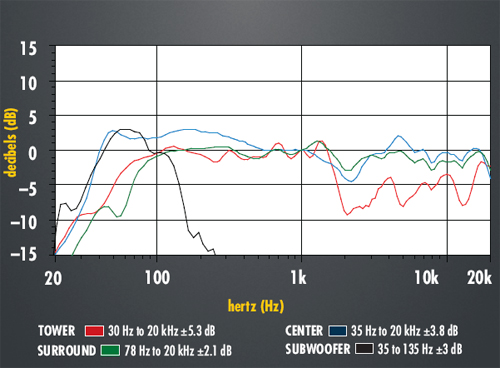Earthquake Sound Titan Telesto Speaker System Page 3

TEST BENCH
Frequency response
Tower 30 Hz to 20 kHz ±5.3 dB
Center 35 Hz to 20 kHz ±3.8 dB
Surround 78 Hz to 20 kHz ±2.1 dB
Subwoofer 35 to 135 Hz ±3 dB
Sensitivity (SPL at 1 meter with 2.8 volts of pink-noise input)
Tower 87 dB
Center 84 dB
Surround 84 dB
Impedance (minimum/nominal)
Tower 1.7/5
Center 6.0/10
Surround 3.4/8
Bass limits (lowest frequency and maximum SPL with limit of 10% distortion at 2 meters in a large room)
IQ-1500 20 Hz at 95 dB, 106.1 dB average SPL from 25 Hz to 63 Hz, 114.2 dB maximum SPL at 63 Hz, bandwidth uniformity 92%
Tower 40 Hz at 80 dB
Center 45 Hz at 81 dB
Surround 80 Hz at 75 dB
Measurements of all speakers were made at 2 meters to ensure that full effects of cabinet diffraction and front panel reflections were included. Response of woofers and ports was close-miked and summed, then spliced to the quasi-anechoic response. The Titan Telesto was measured on the ground (since that is the way it will always be used), and averaged across a ±30° window. The Platine Noirée PN-4421 center was measured atop a 6-foot stand and averaged across a ±45° window. The Platine Noirée PN-2421 surround was mounted on a large piece of plywood at a height of 6 feet, to simulate the acoustical effects of wall-mounting, and averaged across a ±60° window. All of these averaging techniques simulate the way sound arrives at a listener's ears with normal speaker placement.
The Titan Telesto has an unusual frequency response. It's fairly flat to 1.4 kHz, then dives -9 dB by 2 kHz. Above that frequency, it has a few minor bumps and dips, but the average response is down by an average of -7 dB compared to the response below 1.4 kHz. Thus, this speaker will likely sound soft in the treble. Off-axis response is excellent, though; except for the expected high-frequency rolloff, the response is mostly consistent all the way out to 60º off-axis. Actual -3 dB bass response is 45 Hz; although the cabinet is fairly large, the small 8-inch woofer doesn't put out any bottom-octave bass to speak of. Usable bass response (below 10% THD) runs down to 40 Hz. No grille is supplied.
The Platine Noirée PN-4421 center speaker fares better. Its response is reasonably flat and smooth, with a no major anomalies except a very broad dip of maximum -4 dB centered at 2.2 kHz. The treble is down a bit, averaging – 2 dB above 5 kHz. Off-axis response is just okay - no surprise given the four midrange drivers, which seem to interfere with each other at certain angles. At 45º off-axis, a big dip of more than -20 dB appears at 2 kHz. The grille produces almost no change in frequency response, just a very narrow (and probably inaudible) dip of -6 dB centered at 3.7 kHz. Usable bass response is quite good for a center speaker: 45 Hz at 80 dB.
From a measurement standpoint, the star of the group is the Platine Noirée PN-2421 surround speaker. Measured with its grilles on (the way I assume everyone's going to use it), it delivers some of the flattest response I've seen from an indirect-radiating surround speaker. The only surround speaker I've measured that can match it is Paradigm's ACP3 v.2. There's a slight peak at 1.3 kHz, followed by a slight dip at 2.1 kHz, but otherwise it's basically flat. Few main or center speakers measure this well.
The Titan Telesto tower speaker demands decent current from an amplifier. Its minimum impedance is a very low 1.7 ohms and the nominal impedance averages about 5 ohms. The center and surround speakers have much more forgiving impedance curves, but their sensitivity is a little on the low side. They'll need about twice as much power as the Titan Telesto to reach the same volume level.
While the IQ-1500 delivers usable response down to 20 Hz, it's really a "punch sub," delivering its most intense output in the 40 to 80 Hz range. Average SPL from 25 to 63 Hz runs 106.1 dB, and max output is a pretty impressive 114.2 dB at 63 Hz. Its close-miked frequency response shows the output falls off gradually below 45 Hz, but there's still decent bottom-octave output as the passive radiator kicks in below 40 Hz. The defeatable crossover rolls off the bass at about 18 dB per octave. The subsonic filter starts filtering out the deep bass at around 24 Hz, and reduces output by 10 dB at 10 Hz. The ±6 dB EQ controls produce a somewhat more modest effect than advertised: measured response of the controls is ±5 dB at 20 Hz, ±3.5 dB at 30 Hz, and ±4 dB at 40 Hz.













































